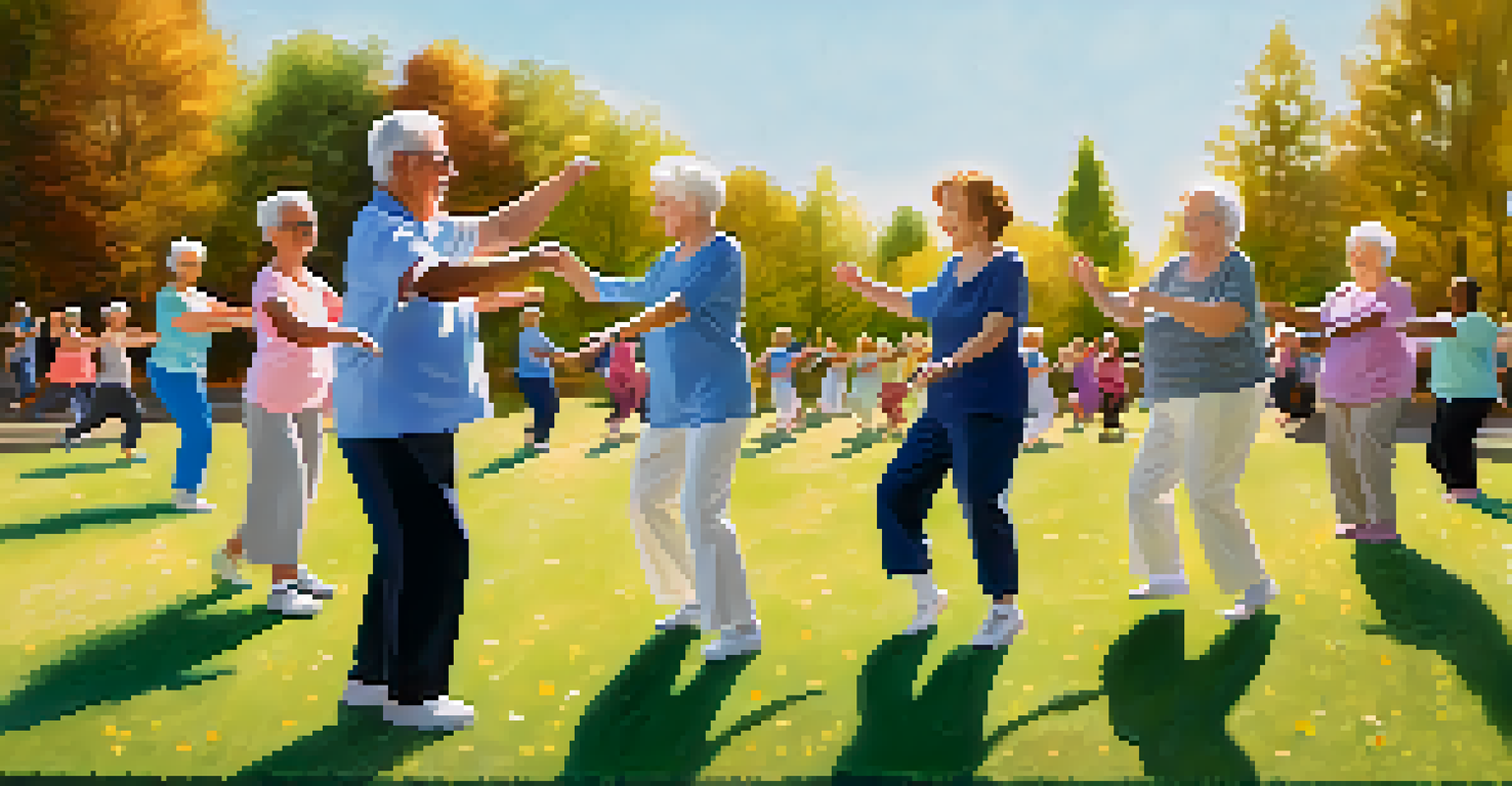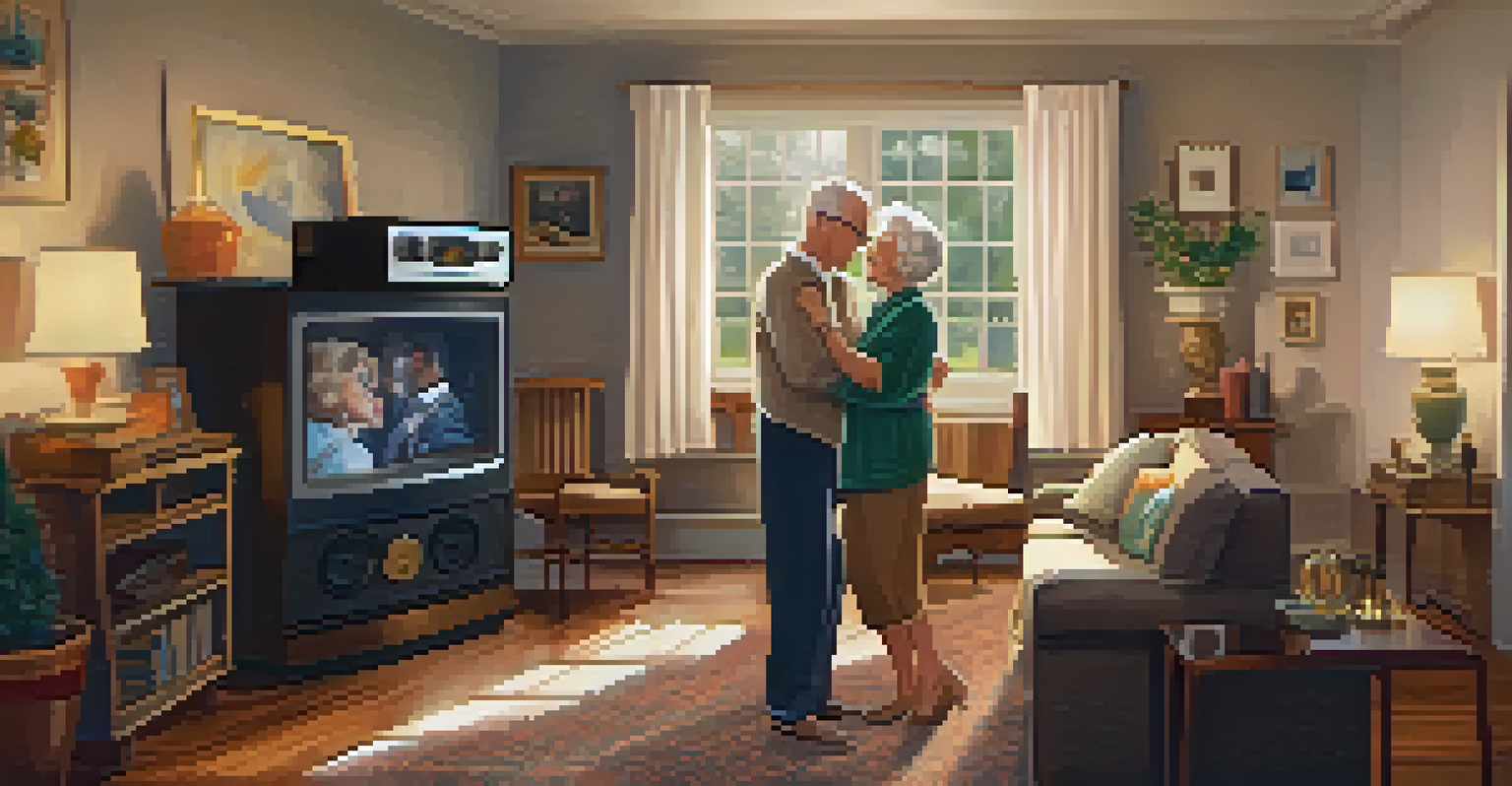Dance as a Social Activity: Building Community for Seniors

The Joy of Dance: A Universal Language for All Ages
Dance is often referred to as a universal language, transcending age, culture, and background. For seniors, engaging in dance can evoke joyful memories and spark a sense of freedom, making it a delightful way to express themselves. It encourages movement and creativity, which are essential for maintaining physical and mental health as we age.
Dance is the hidden language of the soul.
Moreover, dance offers a chance for seniors to connect with familiar tunes and rhythms, which can be both nostalgic and uplifting. Whether it's a graceful waltz or a lively salsa, the experience of dancing can bring smiles, laughter, and a sense of belonging. It’s a simple yet powerful way to break down barriers and create bonds.
As seniors dance together, they form a community rooted in shared experiences and mutual enjoyment. This shared joy can lead to lasting friendships and a support network that enriches their lives, proving that dance is much more than just a physical activity—it's a path to connection.
Physical Benefits of Dance for Seniors
Dancing is not only a fun activity but also a fantastic way to stay fit. It helps improve balance, flexibility, and coordination, all of which are crucial for seniors. Regular dancing can also enhance cardiovascular health, contributing to overall well-being and longevity.

Additionally, dance encourages seniors to engage in physical activity in a way that feels enjoyable rather than burdensome. Unlike typical exercise routines, dancing can be a social event, making it easier to stick with and enjoy. It’s a win-win situation where they can have fun and improve their health simultaneously.
Dance Boosts Physical Health
Engaging in dance enhances balance, flexibility, and cardiovascular health, making it a fun way for seniors to stay fit.
For those who may have mobility issues, there are many forms of seated dance or gentle movements that still provide physical benefits. This inclusivity ensures that everyone can participate, fostering an environment where all seniors feel empowered to move and groove at their own pace.
Cognitive Benefits: Keeping the Mind Sharp
Engaging in dance is not just a workout for the body; it’s also a fantastic exercise for the brain. Learning new dance steps or routines stimulates mental activity, promoting cognitive function and memory. This is particularly important for seniors, as staying mentally active can help ward off cognitive decline.
To watch us dance is to hear our hearts speak.
Moreover, dance requires focus and coordination, which challenges the brain to stay engaged. This dual focus on memory and movement can enhance neuroplasticity—the brain's ability to reorganize itself. It's like giving your brain a workout while you enjoy the rhythm and music!
The social aspect of dancing further boosts cognitive health. When seniors dance together, they engage in conversations, share stories, and create an interactive environment that stimulates their minds. This social interaction is crucial for mental well-being, helping to combat feelings of loneliness and isolation.
Fostering Social Connections Through Dance
One of the most beautiful aspects of dance is its ability to bring people together. For seniors, participating in group dance classes or community dance events creates opportunities to meet new friends and strengthen existing relationships. These connections are vital for emotional health and can combat feelings of loneliness.
Dance often involves partner work or group choreography, which encourages collaboration and communication. This not only enhances social skills but also fosters a sense of teamwork and camaraderie among participants. As they learn and practice together, bonds are formed that can last a lifetime.
Dance Enhances Cognitive Function
Learning new dance steps stimulates the brain, promoting mental activity and helping to ward off cognitive decline in seniors.
Additionally, many dance events cater specifically to seniors, providing a welcoming environment where everyone can feel comfortable and included. These social gatherings promote a sense of belonging, encouraging seniors to share their love for dance and, in turn, their lives with others.
Dance Styles That Appeal to Seniors
There are countless dance styles, each offering unique benefits and joys. Some popular options among seniors include ballroom dancing, line dancing, and even Zumba Gold, which is designed for older adults. These styles not only provide physical exercise but also foster a sense of community as participants often dance in groups.
Ballroom dancing, for instance, is elegant and structured, offering a chance for seniors to learn graceful movements while enjoying the music. Line dancing, on the other hand, is upbeat and easy to follow, making it a fun way to socialize and move without the need for partners. Each of these styles can cater to different interests and skill levels.
Moreover, exploring various dance genres encourages seniors to step out of their comfort zones and try something new. This not only keeps their routines fresh and exciting but also allows them to discover hidden talents and passions they might not have realized they had.
Creating a Dance-Friendly Environment for Seniors
To ensure seniors can fully enjoy the benefits of dance, it’s essential to create a welcoming and safe environment. This includes choosing venues that are accessible, with adequate space for movement and appropriate flooring to reduce the risk of slips and falls. A supportive atmosphere encourages participation and fosters confidence.
In addition, providing options for various skill levels is crucial. Beginners may need more guidance and simpler routines, while more experienced dancers may seek challenges. Offering a range of classes or sessions can help cater to the diverse needs and abilities within the senior community.
Dance Fosters Social Connections
Participating in dance classes creates opportunities for seniors to meet new friends and strengthen relationships, combating loneliness.
Lastly, consider incorporating elements that make dance more enjoyable, such as familiar music and social events. Celebrating achievements, whether big or small, can create a positive experience that motivates seniors to continue dancing and engaging with their community.
Incorporating Dance into Daily Life
Integrating dance into daily routines can be a fun and easy way for seniors to stay active. Whether it’s a solo dance session in the living room or joining a local dance class, finding moments to move can boost both physical and mental well-being. Even a few minutes of dancing each day can lead to significant benefits over time.
For those who may be hesitant to join formal classes, consider starting with simple steps at home. Playing favorite tunes and dancing freely can be a joyful way to express oneself and relieve stress. This informal approach can also build confidence and motivate seniors to explore more structured dance options.

Encouraging family members to join in can make dance a delightful family activity. Whether it's a dance party with grandchildren or a couple's dance night, sharing the joy of dance can strengthen family bonds and create cherished memories that last a lifetime.